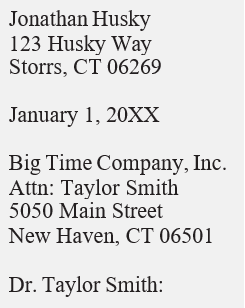What Is A Cover Letter?
A cover letter is a document that serves as an introduction to your résumé and provides the reader with additional context about your skills and qualifications when considering your application. Not only does it reiterate your enthusiasm and qualifications for the opportunity, but it also serves as mini writing sample which can be extremely helpful when applying for a position that requires strong written communication skills.
Constructing A Cover Letter
Much like your position-specific résumé, a cover letter should be uniquely tailored for each opportunity you apply to. Researching the organization and position prior to writing your letter will provide helpful guidance on content to include and attributes to draw attention to. In addition, here are a few other general rules you should follow when formatting your cover letter.
| Margins should be equal on all sides of the page; between 0.5 inch and 1.0 inch | Font size should be between 10 and 12 point | Use a universal font like Times New Roman or Garamond |
| Files should preferably be saved as a .doc or .docx file; PDFs should be used only if needed | Ensure there are no spelling errors or general mistakes – do not rely on spellcheck | Use formal business letter formatting or mirror your résumé’s contact section |
| Limit the document to one page | Do not indent paragraphs | Use direct greetings when possible “Dear Taylor Smith” or “Dear Search Committee”, instead of “To Whom it May Concern” |
| Avoid the use of cover letter templates containing tables and grids | Avoid abbreviations except for states and universal acronyms |
Contact Section
There are two options for arranging the contact section on your cover letter: using formal business letter formatting or mirroring the contact section of your résumé.
1. Formal business-style cover letters should follow a standard block format which aligns all text to the left margin and includes an outgoing address (your contact information), the date, an incoming address (your recipient’s contact information), followed by the salutation.

2. If mirroring the contact section of your résumé, your contact information should be centered on the page (or however it appears on your résumé) with the date, recipient’s contact information, and salutation aligned to the left margin.

Organizing Content
When constructing the body of your cover letter, the content should be separated into four main paragraphs based on the skills and/or experiences you wish to highlight to your reader. These paragraphs should be written without indentation and contain the sentiments outlined below.
Introduction Paragraph
- Why are you writing this cover letter? Specifically mention the position and company to which you are applying
- Make a connection with the reader by mentioning a common professional acquaintance, sharing the name of the company representative you spoke with at a career fair, or expressing how a certain aspect of the position or organization related to you personally
- Conclude the paragraph with a statement that identifies the skills, knowledge, and/or experience(s) you plan to discuss in the next two paragraphs
Body Paragraphs
Focus on one skill or experience you want to write about in each paragraph, then make sure that each one…
- Explains why you are a strong fit for the position and organization
- Shows that you possess the skills/qualifications listed in the position description by providing specific examples of past work, internship, classroom, volunteer, or leadership experiences
- Illustrates why/how your past experiences and skills can add value to the organization
Closing Paragraph
- Thank the reader for reviewing your application materials
- Reiterate your interest in the position/organization by referring to them by name
- Express your willingness to follow up with more information if needed
- Provide your phone number and email address for contact if your contact section does not mirror your résumé
Valediction (signature line)
- Leave a paragraph space after your closing paragraph for your valediction; sentiments such as “Sincerely”, “Kind regards”, “With appreciation”, and “Respectfully” can all be used and should be followed with a comma
- Leave at least two to three paragraph spaces between your valediction and your typed name to include a printed signature – even if you are not physically printing and signing the letter
Cover Letter Sample

